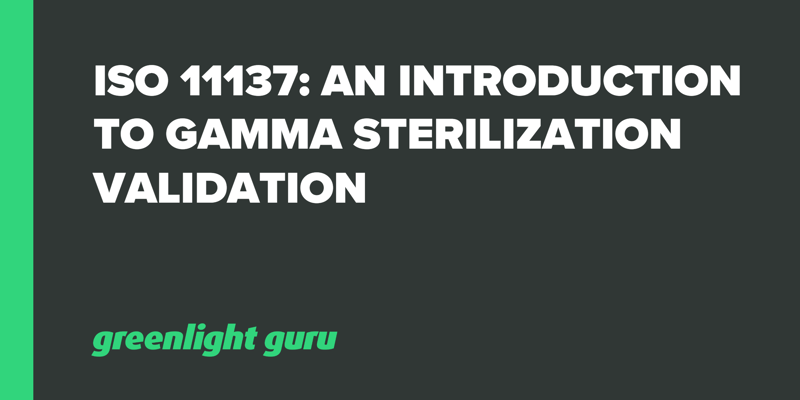ISO 11137: An Introduction to Gamma Sterilization Validation

For many medical device companies, sterilization is one of the final hurdles they have to clear before their device can be marketed. This doesn’t mean it can (or should) be treated as an afterthought, though. Unsterilized or improperly sterilized devices pose a severe risk to patients and users.
Fortunately, there are a number of well-known methods for sterilizing medical devices. This article, specifically, will cover gamma irradiation as a sterilization method and its attendant ISO standard, ISO 11137.
WANT TO BECOME A MEDICAL DEVICE INSIDER? Get VIP access to the best medical device content, checklists/templates & events delivered to your inbox every week by subscribing to our newsletter now!
What is ISO 11137?
ISO 11137 is the international standard governing the sterilization of healthcare products using radiation. It’s broken up into three sections that cover every aspect of radiation sterilization for medical device manufacturers:
ISO 11137-1: Part one of the standard covers the requirements for developing, validating, and controlling the radiation sterilization process. It covers guidelines for sterilization using the radionuclide Cobalt 60 and Cesium 137, which are the two commonly used isotopes that emit gamma radiation.
ISO 11137-2: Part two of the standard provides information about the method manufacturers will use to determine the minimum necessary dose to achieve sterility. It also defines the method used to substantiate the use of 25 or 15 kiloGrays (kGy) for the sterilization dose. A kiloGray is the unit used to measure the gamma rays that are emitted as the radionuclide decays.
ISO 11137-3: Part three of the standard offers guidance for manufacturers to meet the requirements of part one and that relate to dosimetry—the measurement of gamma ray dosage—and its role in developing, validating, and controlling the sterilization process.
How does gamma sterilization of medical devices work?
Gamma irradiation is one of the more common methods of sterilizing medical devices. Gamma rays are simply a form of electromagnetic radiation, like X-rays. The difference is that gamma rays deliver much higher energy, and can penetrate materials like plastic to kill microorganisms on devices that have already been packaged.
The sterilization process starts by placing the source of radiation (usually Cobalt 60, but sometimes Caesium 137) in a radiation-shielded room. Packaged medical devices are then brought in using a conveyance system and circulated around the source of radiation to expose all sides of the product to the gamma rays.
In contrast to sterilization methods like ethylene oxide (EO), gamma irradiation does not require strict humidity, temperature, or pressure controls. The gamma sterilization process also does not significantly increase the temperature of the products being treated, making it ideal for sterilizing heat sensitive devices.
One thing to note is that the future supply of the necessary isotopes is uncertain. The nucleotides decay over time and the global supply of cobalt-60 is not currently meeting the rate of decay, meaning the capacity of gamma irradiation facilities is limited.
What is the process for gamma sterilization validation according to ISO 11137?
The gamma sterilization validation process outlined in ISO 11137 is meant to ensure two critical outcomes:
-
The desired Sterilization Assurance Level (SAL) is met using a minimum dose of radiation. The most commonly specified SAL is 10-6, or one potentially unsterilized device per million.
-
Product functionality is not compromised by exceeding a maximum dose of radiation. A maximum dose must be established and not exceeded during gamma sterilization because gamma rays have the potential to break down the polymers that are used in many single-use medical devices that require sterilization.
ISO 11137-2 offers three related methods for establishing a radiation dose that meets both these requirements.
The first two methods are similar to each other and involve determining the natural bioburden—the number of microorganisms on a product—and verifying the appropriate dose via sterility testing. These methods are designed to be used with products that come in large batches and require at least 100 units of the product.
The third method, known as VDmax, is used for products that are made in smaller batches, when grouping hundreds of devices together is not feasible. Instead of determining the minimum dose required to reach SAL 10-6, this method tests a predetermined dose: either 25 kGy or 15 kGy for products with a lower tolerance for gamma rays.
Regardless of the method used, ISO 11137 states that manufacturers must also perform quarterly dose audits as part of ongoing process validation.
WANT TO BECOME A MEDICAL DEVICE INSIDER? Get VIP access to the best medical device content, checklists/templates & events delivered to your inbox every week by subscribing to our newsletter now!
Stay compliant with ISO 11137 and validate your processes faster with Greenlight Guru
The complex and specific procedures involved in the sterilization validation process are just one of the many things that make medical device manufacturing unique. Given the number of regulations and standards like ISO 11137 that medical device manufacturers must understand and follow, it only makes sense to use an industry-specific platform to plan, execute, and document all of your quality and risk management activities.
That’s why at Greenlight Guru, we built our QMS software based on the latest FDA and ISO standards, as well as best practices of medical device manufacturers who lead the industry in production of high-quality devices.
If your medical device company is ready for a comprehensive, turn-key solution that meets your unique needs, then get your free demo of Greenlight Guru today →
Looking for a design control solution to help you bring safer medical devices to market faster with less risk? Click here to take a quick tour of Greenlight Guru's Medical Device QMS software
Etienne Nichols is the Head of Industry Insights & Education at Greenlight Guru. As a Mechanical Engineer and Medical Device Guru, he specializes in simplifying complex ideas, teaching system integration, and connecting industry leaders. While hosting the Global Medical Device Podcast, Etienne has led over 200...










